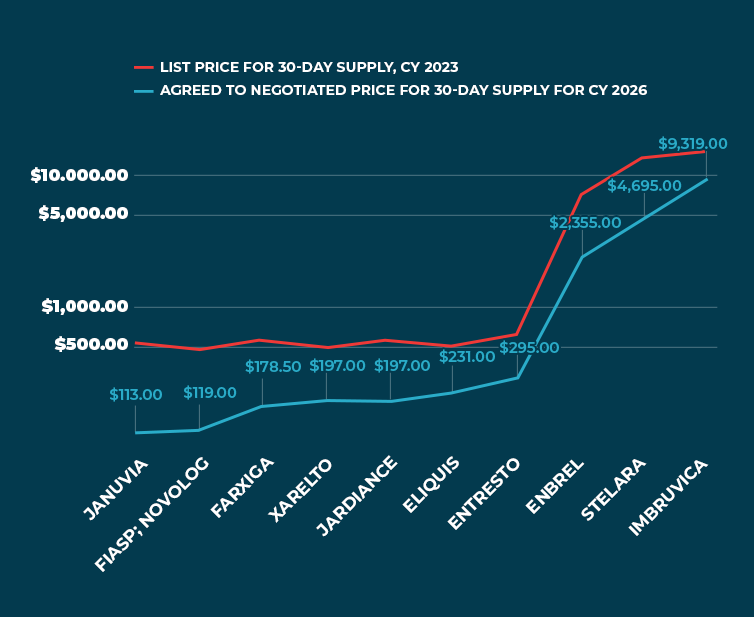The Centers for Medicare & Medicaid Services (CMS) has taken significant steps to curb the rising cost of prescription drugs through the Medicare Drug Price Negotiation Program. As we have written about before, this groundbreaking initiative empowers Medicare to negotiate prices for some of the most commonly used and costly medications for chronic conditions such as diabetes, heart disease, blood clots, psoriasis, and certain cancers. These negotiated prices, set to take effect in 2026, promise substantial savings for Medicare beneficiaries, with some medications seeing discounts of up to 79% for a 30-day supply.
Medication price breakdown: unveiling the biggest and smallest savings
The majority of the drugs included in this negotiation program are used to treat diabetes and heart conditions. See details and a chart below:
- Leading the charge in savings are Januvia, a diabetes medication, with a remarkable 79% discount, and Fiasp and NovoLog, also for diabetes, with a 76% reduction. These substantial price cuts will offer much-needed relief to millions of Medicare enrollees who rely on these medications to manage their chronic conditions.
- Eliquis, a medication used to prevent blood clots, boasts the highest number of Part D enrollees at 3,928,000 in 2023. The negotiated price of $231 per month translates to an annual cost of $3,480, a significant decrease — 56% — from its 2023 price.
- Stelara, while having fewer enrollees, presents the most impressive savings by amount. This medication, used to treat psoriasis, psoriatic arthritis, Crohn’s disease, and ulcerative colitis, had a list price in 2023 of $13,836 for a 30-day supply. With the negotiated price, this will plummet to $4,695, resulting in an annual saving of $109,692 (if prescribed for 12 months).
- Imbruvica, a cancer medication, stands out as the second most expensive drug on the list, and has the smallest, yet still significant, discount in 2026. Even with the negotiated price of $9,319 for a 30-day supply, it has the lowest discount at 38%. Only 17,000 enrollees were prescribed this medication in 2023 but prescriptions may increase with this new price in 2026.

The benefits of Medicare negotiating drug prices for the first time
The ability for Medicare to negotiate drug prices marks a turning point in the fight against exorbitant medication costs. This newfound power has the potential to:
- Reduce out-of-pocket costs for beneficiaries: Lower drug prices will directly translate to reduced costs for Medicare enrollees, making medications more affordable and accessible.
- Curb rising healthcare spending: By reining in drug prices, Medicare can help control overall healthcare spending, benefiting both beneficiaries and taxpayers.
- Foster innovation and competition: The negotiation process may encourage pharmaceutical companies to develop more cost-effective medications and promote competition within the industry. However, It’s important to note that lobbyists for pharmaceutical companies are claiming the opposite, that lower profits would mean lower investment in research and development.
Brand name, high-quality drugs are less cost-prohibitive: Before these new prices, patients may not have been able to afford these prescriptions at all, even if they needed them to manage their conditions. Providers may have found more affordable but less effective drugs to prescribe instead. Now, with negotiated prices, more patients can have access to these high quality medications.
What this means for the future of Medicare
The Medicare Drug Price Negotiation Program heralds a new era of affordability and accessibility for prescription medications. The significant savings achieved through these negotiations will have a profound impact on the lives of millions of Medicare beneficiaries, allowing them to better manage their health without the burden of excessive drug costs. As this program continues to evolve, it could reshape the pharmaceutical landscape. The program has already selected 15 more drugs to start negotiating for new prices to take effect in 2027.